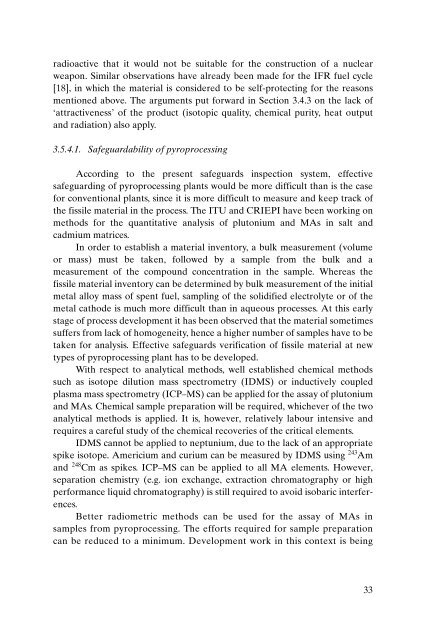TRS435_web
TRS435_web
TRS435_web
Create successful ePaper yourself
Turn your PDF publications into a flip-book with our unique Google optimized e-Paper software.
adioactive that it would not be suitable for the construction of a nuclear<br />
weapon. Similar observations have already been made for the IFR fuel cycle<br />
[18], in which the material is considered to be self-protecting for the reasons<br />
mentioned above. The arguments put forward in Section 3.4.3 on the lack of<br />
‘attractiveness’ of the product (isotopic quality, chemical purity, heat output<br />
and radiation) also apply.<br />
3.5.4.1. Safeguardability of pyroprocessing<br />
According to the present safeguards inspection system, effective<br />
safeguarding of pyroprocessing plants would be more difficult than is the case<br />
for conventional plants, since it is more difficult to measure and keep track of<br />
the fissile material in the process. The ITU and CRIEPI have been working on<br />
methods for the quantitative analysis of plutonium and MAs in salt and<br />
cadmium matrices.<br />
In order to establish a material inventory, a bulk measurement (volume<br />
or mass) must be taken, followed by a sample from the bulk and a<br />
measurement of the compound concentration in the sample. Whereas the<br />
fissile material inventory can be determined by bulk measurement of the initial<br />
metal alloy mass of spent fuel, sampling of the solidified electrolyte or of the<br />
metal cathode is much more difficult than in aqueous processes. At this early<br />
stage of process development it has been observed that the material sometimes<br />
suffers from lack of homogeneity, hence a higher number of samples have to be<br />
taken for analysis. Effective safeguards verification of fissile material at new<br />
types of pyroprocessing plant has to be developed.<br />
With respect to analytical methods, well established chemical methods<br />
such as isotope dilution mass spectrometry (IDMS) or inductively coupled<br />
plasma mass spectrometry (ICP–MS) can be applied for the assay of plutonium<br />
and MAs. Chemical sample preparation will be required, whichever of the two<br />
analytical methods is applied. It is, however, relatively labour intensive and<br />
requires a careful study of the chemical recoveries of the critical elements.<br />
IDMS cannot be applied to neptunium, due to the lack of an appropriate<br />
spike isotope. Americium and curium can be measured by IDMS using 243 Am<br />
and 248 Cm as spikes. ICP–MS can be applied to all MA elements. However,<br />
separation chemistry (e.g. ion exchange, extraction chromatography or high<br />
performance liquid chromatography) is still required to avoid isobaric interferences.<br />
Better radiometric methods can be used for the assay of MAs in<br />
samples from pyroprocessing. The efforts required for sample preparation<br />
can be reduced to a minimum. Development work in this context is being<br />
33


